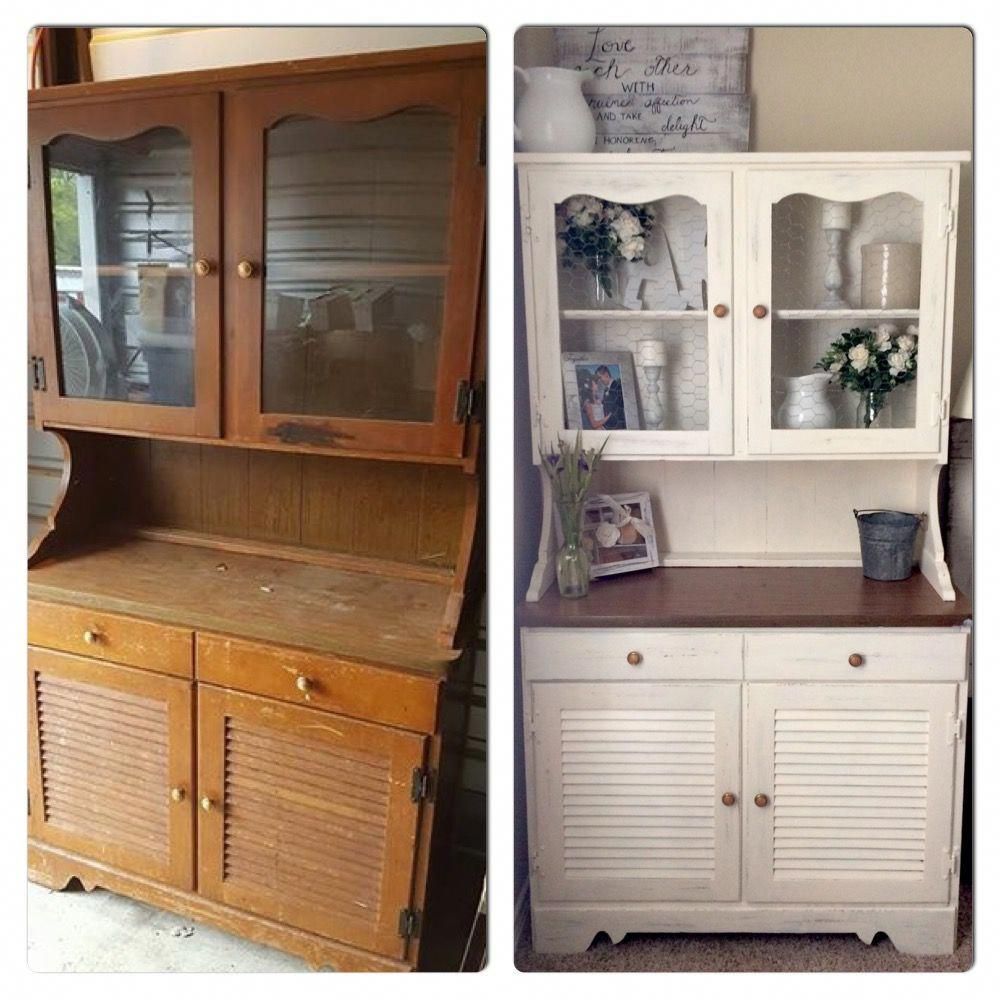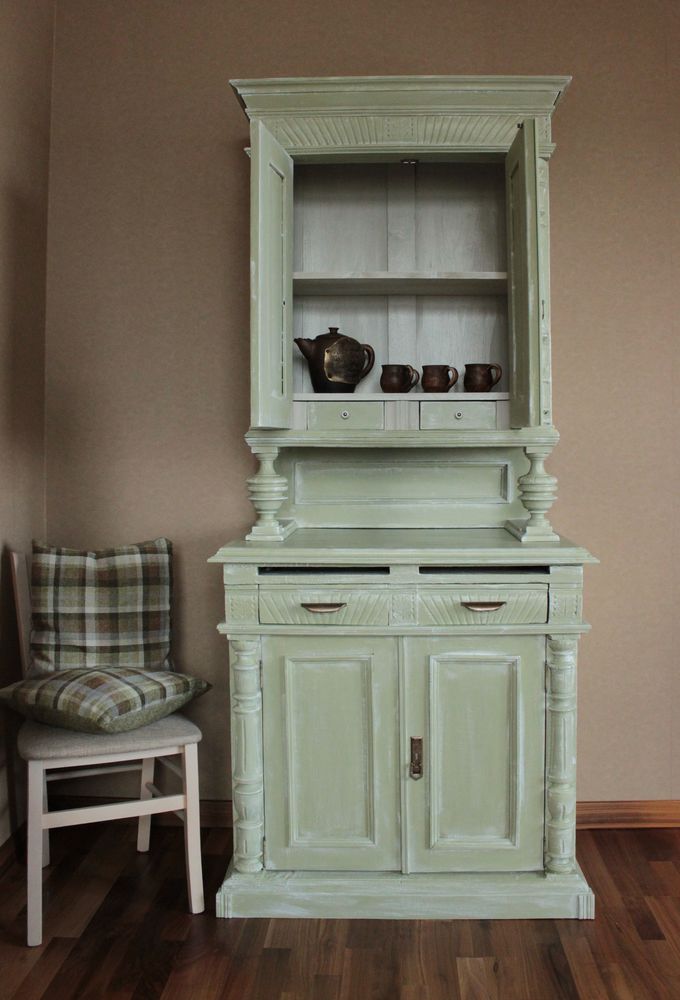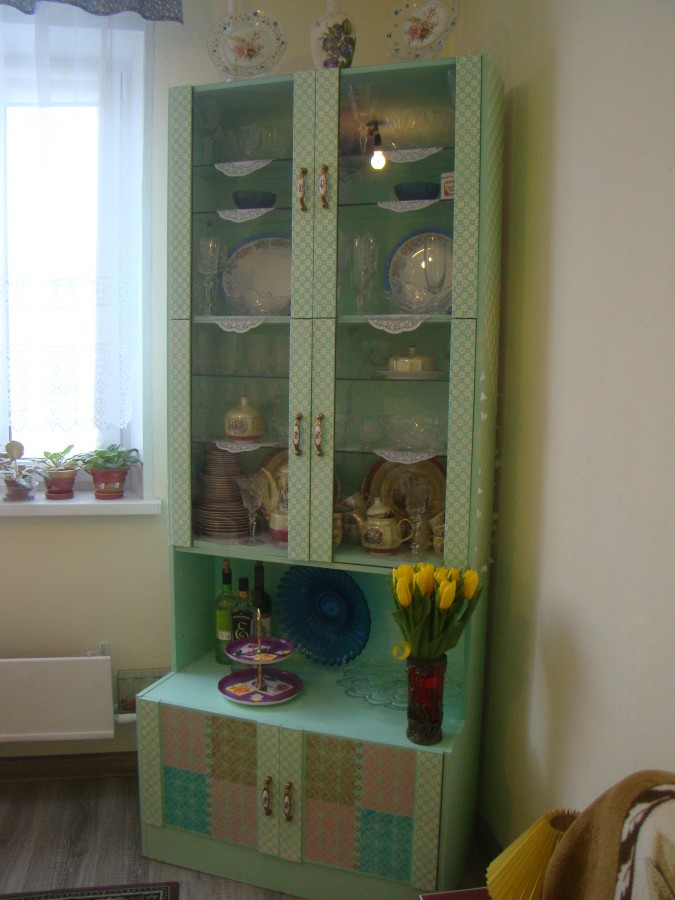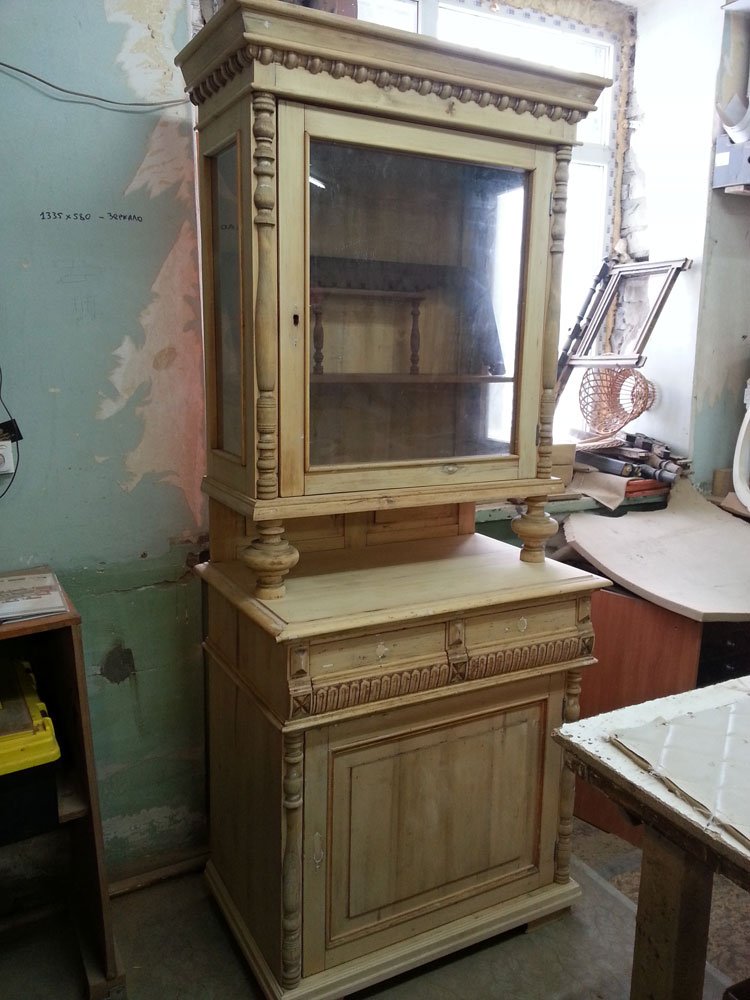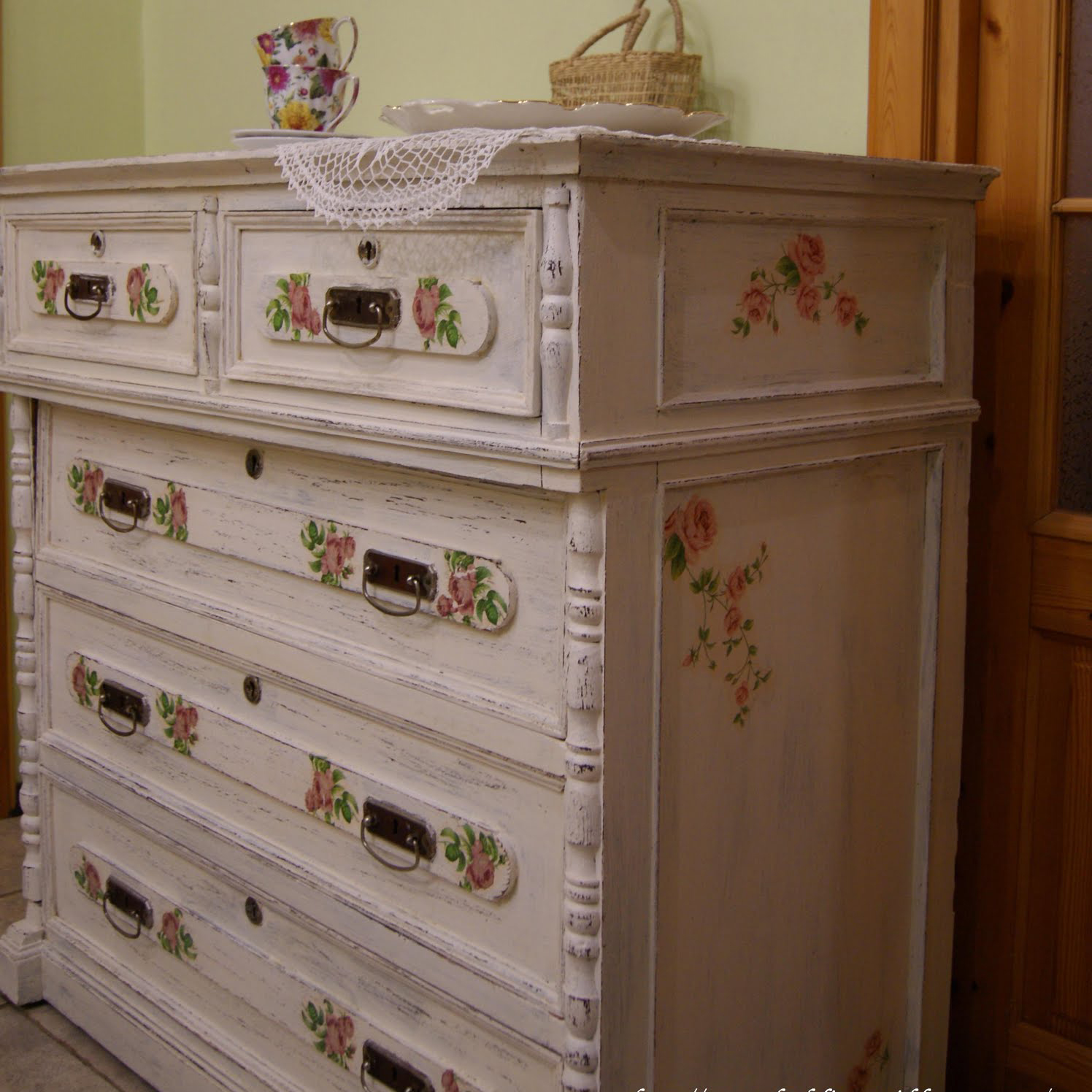We restore an old cabinet: repainting, aging, decoupage
Before starting work, you need to come up with (or better sketch in color) how the finished product will look. Having considered this moment, you can proceed to the acquisition of the necessary materials. We will need:
- synthetic paint brushes of medium hardness (one for paint and one for varnish - at least two centimeters wide);
- paint for wood;
- sandpaper (harder and finer);
- water-based varnish for wood (matte or glossy - at your discretion);
- acrylic primer for wood;
- masking tape;
- paraffin candle;
- decoupage napkins or drawings printed on thin paper;
- PVA glue;
- spray bottle with water.
Pneumatic airbrushes, spray guns, texture guns
Step-by-step instruction
Step 1. First of all, you need to remove all the fittings, and you need to start work by cleaning the surface of the cabinet from the old varnish. To make the work go faster, it is better to use a sander, but if there is none, you can also sand the cabinet manually.
To process the surface of the chiffoner, a small round nozzle is enough
Step 2. The entire surface of the cabinet, which is planned to be painted, must be coated with a primer. You need to apply the composition with a brush in one layer, and then dry for the time recommended by the manufacturer (usually the primer dries for at least three hours).
The primer is usually colorless
Step 3. We seal the parts that we do not plan to paint with masking tape. Paint the rest of the elements with a brush in one layer. Leave to dry, then, if necessary, cover the surface with a second coat of paint.
The first layer can be applied with white paint, the next layer is already colored
Step 4. Apply paraffin wax. With a paraffin candle, we need to process those areas that we plan to make aged (for example, the side edges). This technique will allow you to remove part of the paint layer and expose the previous one. This achieves the "scuff" effect, which is relevant for old furniture.
You need to apply paraffin in a fairly dense layer.
Step 5. Next, the cabinet needs to be covered with another layer of paint - this time it should be slightly lighter than in the previous layer (you can add white paint and stir). Doors and protruding elements, if desired, can be painted with a different shade or color, having previously glued the joint lines with masking tape.
Strips of tape will allow you to draw even boundaries between shades
Step 6. We decorate individual elements (in our case, drawers and door ends) using the decoupage technique. To do this, apply a napkin with a pattern to the surface of the cabinet, moisten it with water from a spray bottle, then smooth it with a brush. After that, cover the napkin with a layer of PVA glue and wait for it to dry.
PVA glue dries in about 20-25 minutes
Step 7. The finished cabinet is varnished in two layers (each layer must be dried according to the instructions).
Work result
Decorative elements
If the main surface of the sideboard is in good condition (or, for example, you want to preserve the charm of antiquity, while only slightly updating the look of the item), you can add various decorative elements. The easiest way is to draw pictures on the doors or walls of the sideboard. For this, it is most convenient to use ready-made stencils (even a person who does not have special drawing talents can use this method).
However, some rules must be followed:
- Clean the place of drawing from dust and dirt, cover with varnish.
- Attach the stencil to the desired place, fix it.
- Dilute the paint to medium thickness (too thick or liquid composition will not work).
- The coating should be applied with a sponge in a thin layer 1-2 times.
- After the paint has dried, cover the finishing area with a protective varnish.
From an old sideboard - a sideboard "antique"
Antique furniture is always in fashion - it adds an aristocratic touch to the entire interior. It's nice that this technique can well be done by hand, which means it's cheap. There are several methods for artificial aging, choose the one that suits you best.
Method 1 - craquelure varnish
Additionally, you should purchase craquelure varnish in specialized stores, all other materials have been described above.
Description of work:
- after removing the old coating and sanding, apply a special craquelure varnish to the surface. It has the ability to transform the entire surface into a canvas cracked, as it were from old age;
- after the previous composition has dried, paint or transparent varnish should be applied to the surface of the sideboard.
After all the procedures, you will receive an antique sideboard in a marvelously short time. It should be noted that using paint in this way is more preferable - the effect will be brighter.
Method 2 - mechanical aging
For this method, you need to prepare two stains on a different basis, a shellac primer and a restoration wax.
Description of work:
- after cleaning old varnish or paint, apply water stain as a base;
- lighten the areas that are more visible with a dampened sponge;
- after drying, you need to sand the places that will be darker;
- now apply the stain again with a different base;
- after the second layer of stain has dried, fill all the places with shellac primer using a brush;
- using a metal brush, rub in the restoration wax, moving it along the fiber;
- after the wax has dried, wipe the sideboard with a soft cloth;
In fact, there are many more ways to age. Masterpieces of unique beauty are created by the "shashel" method, but this is within the power of those who are familiar with carpentry.
Step-by-step instruction
Moving on to the direct implementation of restoration work, you should follow the sequential instructions. This will help to correctly carry out the restoration and prevent common mistakes.
We disassemble and remove all removable parts
For the convenience of restoring the sideboard, it is recommended to disassemble the product so that each detail can be processed separately. When disassembling, all parts should be removed, remembering their location for further assembly in the reverse order.
Shelves
As a rule, the shelves in the sideboard are not supported by fasteners and are located on several metal parts that are embedded in the walls. With this design, it is enough to raise the shelves and pull them out of the sideboard.
Fittings
You can unscrew the fittings using screwdrivers. To restore the appearance, repair or replace, hinges, door handles, legs and other elements are removed.
Glass
In order not to break the glass inserts in the sideboard during the restoration, you must first pull them out. If the glass is inserted into wooden frames, it is easier to remove them completely. In situations where individual glass elements cannot be removed, they are covered with paper or masking tape.
Cleaning the old pavement
Having disassembled the buffet, they begin to process the old coating. You can remove the top layer with a spatula or a special furniture scraper. Then the surface is rubbed with fine-grained sandpaper so that the wood pile does not create problems when degreasing and applying paint. The polished elements are removed to a clean place as they are processed for further stages of the restoration.
Washing and degreasing
After cleaning the old coating, the parts of the sideboard are shaken off of dust and degreased. To effectively degrease the surface, you can use white spirit or ordinary alcohol. After applying the product, you need to wait until it dries.
Puttying
The degreased parts of the sideboard are inspected for delamination and irregularities, after which the cracks are putty.When performing the work, the following recommendations should be taken into account:
- the width of the spatula should be slightly larger than the crack or unevenness in order to cover the defect in one motion;
- before direct use, the putty must be thoroughly mixed;
- if the gap on the wooden surface is too deep, it is better to fill it with putty several times, allowing each previous layer to dry.
The putty process itself is simple: apply a sufficient amount of the mixture to the spatula, and then, pressing it to the surface, make a downward movement. With an additional movement, you need to remove excess material, if they remain.
Grinding
The use of an automatic grinder allows you to speed up and simplify the workflow. Work should be done in the garage or outdoors as sanding creates a lot of waste, including dried paint, dust and lacquer pieces.
Padding
For processing a wooden sideboard, you can use the following types of primer:
- Alkyd. Used if the wood has not been previously processed. The primer allows you to make the surface smooth and even. Drying time is 12-16 hours.
- Polyurethane. The composition is based on polyurethane synthetic resins, solvent and tonic additives. The material is suitable in cases when it is planned to cover the sideboard with parquet varnish.
- Silicone acrylic. After applying this type of primer, the tree becomes more resistant to fluctuations in atmospheric humidity.
- Spray can. It differs from other varieties in the way it is used. If in other cases you need to use a brush and roller, then here you will need to spray the structure. The advantages are the ability to handle hard-to-reach areas and quick drying.
Painting
It is better to start painting with the main surfaces of the sideboard, and then move on to the decorative elements. As a rule, the paint is applied in two layers, but if you want to leave the visual effect of aging of the tree, one thin layer will be enough.
Decorating
There are several options for decorating a prepared wooden surface. The use of different techniques allows you to change the appearance of the sideboard and make it more sophisticated.
Decoupage
Decoupage involves decorating wooden surfaces with decorative applications using napkins with images. Drawings are cut out of napkins and transferred to a tree. Then the surface is covered with acrylic paint and varnish to preserve the pattern.
Benefits of DIY
If a home craftsman is “friendly” with carpentry tools, it will not be difficult for him to deliver something pleasant to the hostess and make a buffet with his own hands, which is necessary in any kitchen.

For maximum convenience and comfort, it should be equipped with not only beautiful, but also functional furniture, such as a sideboard.
A great solution for any home is the installation of a corner kitchen cabinet.
A self-made kitchen cabinet has a number of advantages over its "store brothers":
- you can choose a unique design for it;
- pick up the material to your liking;
- use original fittings;
- choose the color scheme of the sideboard that best suits the kitchen interior.

To make the interior original, you can make it yourself, putting your soul into the work, using any materials.

The most important nuance when installing such a cabinet is the calculation of the trajectory of the door opening movement.
In addition, wood products are extremely beneficial to health: they do not contain toxic compounds and do not emit harmful substances, but they fill the room with aromas of essential oils.

Sideboards and sideboards for the kitchen do not differ much and are very similar in appearance to each other, because the wardrobe is considered the progenitor of both.

The kitchen sideboard is a great solution for the interior of the kitchen.
The wooden sideboard is durable and comfortable.It will serve for more than a dozen years, it is easy to restore and repair it.

A natural wood sideboard will look rich and sophisticated, but at the same time, it will cost a lot more.
Another important advantage of making a kitchen cabinet with your own hands is the ability to make it in the original configuration and dimensions that best meet the convenience and comfort.

In order to get a beautiful product and at the same time not spend too much, the furniture body can be made from cheaper raw materials, such as chipboard, and the facades from more expensive and beautiful ones.
Decoupage of an old sideboard - the atmosphere of Provence
To perform decoupage, you will need to supplement the list of materials and tools.
Decoupage materials:
- new antique handles and door hinges;
- napkins for decoupage;
- PVA glue;
- White paint;
- furniture varnish;
- sandpaper;
- stain;
- putty for wood;
- metal brush.
In a craft store, you can buy decoupage napkins. Choose the ones that you liked, but in the floral theme of blue, lavender or burgundy flowers. If you have chosen furniture handles with ceramic inserts, then this pattern should be in harmony with the image on decoupage napkins. We dealt with the old coating in the previous sections. In addition, all old door hinges must be replaced, warped drawers must be repaired, and other repairs must be made, if necessary.
We proceed to a step-by-step description of the do-it-yourself sideboard decoupage:
quickly wipe the entire surface of the sideboard with a damp cloth so that moisture is not absorbed;
cover all cracks with wood filler;
go through the entire surface with sandpaper, removing all defects;
cover the wood with wood stain and let it dry;
now is the time for a unique aging technique - apply wax in all corners, drawing on them with a wax candle;
cover the sideboard twice with white paint, however, all pale pastel shades, especially mint and lavender, are well suited for Provence;
after the paint has completely dried, remove the wax by carefully manipulating with a metal brush. This is a simple and effective technique for imitating antiquity;
We coat the napkins with PVA glue and glue them on the lower or upper doors, carefully smoothing them to remove air bubbles;
to make the glue rise faster, direct a stream of hot air from a hair dryer at it;
cover the decoupage places with clear varnish. Do the same with the places of aging.
The new Provence-style sideboard is ready, the only thing I would like to add is that if there were glasses in the sideboard, then they can either be painted over or replaced. And, of course, don't forget to put a lavender bouquet on it in a white ceramic vase.
Required tools
Before starting restoration work, you should prepare tools that will be useful for processing a wooden surface. Having at hand the necessary list of tools, it will be possible to quickly complete the work without being distracted by the search for inventory.
Furniture scraper
A metal paint scraper is often used instead of a spatula to remove paintwork. The tool effectively cleans the surface from excess paint, grout, adhesives and polyurethane foam. The presence of a rubberized handle with a textured coating makes the scraper convenient to use. The fastening mechanism provides a strong fixation of the specially sharpened blade.
Foam sponge
Thanks to its high density polyurethane, the sponge helps to remove dirt from any surface. It is better to purchase a foam sponge with a large area to speed up the cleaning process of the sideboard. This type of sponge has the following advantages:
- absorbs water and cleaning agents well;
- forms copious amounts of foam;
- does not leave fibers and streaks;
- easy to wring out and dries quickly.
Brush set, water repellent varnish
To paint a wooden surface, you need brushes of different sizes.Large brushes paint the main area, and small ones are used for hard-to-reach areas. After staining, a water-repellent varnish is applied to the sideboard.
Wax, stain or acrylic
These products are used to restore the shade of the wood and improve the appearance of the sideboard. Of the options proposed, an oil-based stain is most often used, which allows you to make the color of the tree as natural as possible. The stain is absolutely safe for human health and the environment, dries quickly and protects the surface from destruction.
Clamps for wood
Clamp means a device with a clamping mechanism for holding products during processing or when gluing individual parts. Using clamps, the tree is fixed in a stationary state, which simplifies further work. Clamps design includes an F-frame or brackets
Also an important component is the movable part, which compresses or releases the locking elements. The movable element is driven by force
Adhesive, quality solvent for nail polish remover
You can remove the old layer of varnish using a special solvent, which is sold in any hardware store. Glue will be needed in situations where the sideboard has begun to exfoliate or some decorative elements are not securely fixed.
Fittings
The door hinges and sideboard handles wear out over time, cease to properly fulfill their purpose and lose their original appearance. During the restoration, the fittings should be replaced by purchasing new sets.
Electric jigsaw
Using a jigsaw, you can effortlessly cut wood and make curly cuts. Modern types of tools are equipped with speed controllers, noise and vibration dampers. For safety reasons, there is a guard over the guide saw of the electric jigsaw, which protects against accidental contact with the saw element.
Marker
You can apply markings for cuts and installation of decorative elements using a marker. It is better to use a permanent marker so that the markings will not be erased in the process of doing the work.
Fasteners
Fasteners are used to fix the top of the sideboard to the base. You can also use wall brackets to secure the cupboard in one place, to ensure its stability and immobility.
DIY buffet restoration
Most of the good old furniture of the Soviet era in the 70s and 80s was taken to the dacha. It was operated, to put it mildly, not carefully. Carved sideboards, oak, walnut, antique and 60s, rustic, white painted, with mirrors and stained-glass windows, they ask to be put in order with their own hands.
How to restore old furniture with your own hands
1. Solve. Why is this done? What should be the result?
2. Assess the depth of damage and your strength. Wake up you do it in an equipped workshop or at home
This is especially important when choosing varnish or paint, solvents and cleaners.
3. Draw up a work schedule.
4. Carry out work in strict sequence: cleaning, carpentry, finishing. This is usually done the other way around. First they paint, and then it turns out that the veneer has risen, the paint or varnish on the old coating has not lay evenly. A layer of white paint does not hide dark spots. No matter how much you paint, they still shine through. Cracks on the walls, which became more noticeable after painting in light colors. The tree has been eaten away by a furniture beetle. The antique mirror has faded, which was not noticeable under the layer of dust before. A pair of legs is not enough at all ...
It is imperative to restore old furniture with your own hands (restoration means a set of actions to preserve an item). Try new materials, study technologies, analyze mistakes, go to the goal. Perseverance and persistence are the foundation of success.
If you have any questions about the restoration of an antique sideboard, sideboard, table, wardrobe, antique armchair, sofa, or any other antique furniture, ask questions by phone or via our mail.
Estimated cost of restoration (price as of January 9, 2019)
| Price, rubles | |
| Chair | 5000 — 20000 |
| Armchair | 10000 — 30000 |
| Sofa | 30000 — 60000 |
| Cost, rubles | |
| Table | 10000 — 40000 |
| Buffet | 30000 — 80000 |
| Cupboard | 30000 — 80000 |
Restoration of paintwork
By sending us a completed form with photographs, as well as asking a question, you will receive full information about the item (what it is, material, age), the cost of restoration work. Then the restorer will come to the site, examine it, and determine the final price of the restoration.
The final price will not change. Check out is free.
How to make a wardrobe or chest of drawers from a sideboard
The difference between a wardrobe and a sideboard is, perhaps, not so much external as functional.
A sideboard is usually understood as a wardrobe in which dishes and kitchen textiles are stored. Personal belongings are put in the closet. The top doors of the sideboards are traditionally glazed. The bottom of this piece of furniture consists of drawers. Cabinets are often made entirely of wood, although glass and stained-glass windows are also used here.
- If you need to convert a sideboard into a cabinet, you can replace some of the glass elements with wooden ones, or made of plywood, chipboard, etc.
- Another option is to transform the glass using a special film from transparent to colored and not translucent.
- Also, most likely, you will have to change the color of the sideboard so that it fits organically into the living room.
- Recently, it is not uncommon to see master classes on converting old unnecessary sideboards of the Soviet era into multi-colored wardrobes for children's games.
- The chest of drawers is a vertical row of drawers. It is installed in bedrooms and living rooms, allowing you to keep personal items and clothing out of prying eyes. If the lower part of the sideboard consists of drawers, stripping this item of the top, you can get a chest of drawers. In some models of furniture, individual elements can be disconnected from the general structure without problems, in others you will have to use a saw.
So, as you can see, there are many ways to give old furniture a second life. The main thing is to have a desire to work with your hands, as well as a good imagination.
Are you wondering how to make a wardrobe out of a sideboard? Then watch the following video, where a wardrobe will be made using the example of an old sideboard-chest of drawers:
Restoration of wooden furniture. 12 cool ways to update old furniture
Old furniture can be slightly changed externally and then it will perfectly fit into your conceived interior.
What are the ways to upgrade furniture?
1. Decor with paper.
Do you want to change the color of your furniture to an unusual, non-standard one? Old wallpaper, pieces of beautiful paper are perfect.
Paper is glued to the cleaned surface of the object using PVA glue or wallpaper glue.
The principle is the same as when gluing wallpaper - after applying the glue, the paper is left for a couple of minutes to get wet

It would be a good idea in the nursery to update furniture using old maps.

The idea, by the way, is very popular.

Also, the remains of wallpaper, beautiful paper are suitable for decorating furniture.

A chic idea to update the sides of the boxes with paper. It turns out quite original.

2. There are ready-made stickers - sticky paper. With its help, you can update the surface of furniture with unusual patterns.

More often, old furniture is updated with ordinary vinyl film.

People with imagination get creative with film. One drawback - if not glued correctly, the film is short-lived in use.
But the film is good for beginners "Furniture Renovators", will close all the flaws, cracks.

There is a film with figures of various animals, flowers. Usually such a film is used for a children's room.

3. Decorative items.
If the furniture is boring, you can decorate it with plastic elements that are sold in hardware or art stores.
Also, the elements can be cut out of plywood with a jigsaw if you have not found ready-made ones for sale.
4. Decor with a cloth.
Furniture is decorated with fabric in our time.

There is also a new technique for working with fabric, Patch decor.
Pieces of fabric impregnated with PVA glue are pasted over furniture in a different order in the Patchwork style.


The patch decor uses not only fabric, but also various elements of fabric and cord.
Tools and materials for restoration
The main material is already there - a chair. To bring it into its proper form, we take the following "ingredients" for work:
- Furniture foam rubber for the seat (choose the thickness according to the level of love to sit - hard, not very hard or soft);
- Furniture stapler;
- Stain and varnish;
- Brushes 45 mm wide, hard, 2 pieces;
- A sheet of 4-ply plywood for the seat (replacement is required if you don't want to fall like at school);
- Furniture glue "Moment joinery";
- Clamps for fastening chair elements;
- Furniture tapestry (sold in furniture and regular fabric stores);
- Hammer, wooden mallet, grinder, screwdriver, drill, jigsaw;
- Screws, metal corners to strengthen the structure;
- Five free days for the work itself (we assume that the glue needs to dry out, like varnish and stain, every day).
Carpentry glue
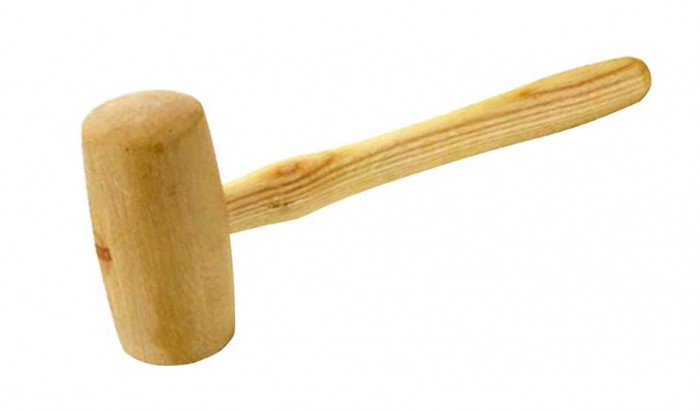
Wooden mallet

Jigsaw

Plywood seat

Brushes
Furniture tapestry

Furniture foam rubber

Furniture stapler

Furniture corner

Stain and varnish
Grinder

Screwdriver
Screws and screws

Clamps
Does the set inspire concern only with its enumeration? For a novice master, this is only a small part (for more experienced ones, this list can go up to fifty points, and work on the restoration of a chair with decoration can take a month). Moving on to the pleasant part of any job.
Beautiful examples
This photo shows the sideboard, restored in Provence style using decoupage. The combination of two non-standard colors (lilac and pale green) creates the effect of ease of perception. This color scheme has a positive effect on the mood of the beholder and causes a positive emotional response.
Showcased here is the buffet, restored to preserve its natural wood tone. This solution makes it possible to bring its visual design closer to the original and helps the observer to feel the presence of antiquity. A similar effect is achieved thanks to a tinted paintwork and darkening of the protruding parts.
Removal of chips and cracks
Therefore, if there is no uncertainty that it will be possible to carry out repairs at home, it is better to contact the master.
If you decide to do it yourself, you need to stock up on the necessary minimum of tools:
- White spirit (nail polish remover);
- Stain of the desired shade;
- Primer for wood;
- Fine sandpaper (100, 180, 300, 800, 1200 and 3000);
- Wood putty;
- Masking tape;
- Roller or brush.
Clean the damaged area from the varnish with White Spirit, treat the wood with a primer, then putty.
After drying, level the filler to the surface with sandpaper. Remove dust with a damp cloth and apply stain to obtain the desired shade.
It is important to apply the stain exclusively to the putty area, without getting on the tree. Otherwise, the wood will change color, and then you cannot do without major repairs.
After complete drying it can be varnished. The varnish should be applied with a brush or roller, depending on the area of the site.
Each new layer can be applied only after the previous one is completely dry and preliminary sanding with 600 or 800 sandpaper.
First at 1200, and then at 2500 or 3000. When finished, wipe with polish, or furniture wax, until a glossy surface is obtained.
Features of the restoration of a wooden table
Even the highest quality furniture cannot last forever. Over time, the surface of the table loses its original appearance.Small cracks, chips appear on it, the varnish begins to wear off, and the fasteners cease to withstand the load. The restoration of an old table is a major renovation, which primarily involves the renewal of damaged parts.
At the same time, it is very important to understand that chipboard is almost beyond repair. It is better to simply discard the old surface, and put a new one in its place.
Before updating the countertop, it is imperative to remove the old finishing coating. If it is a painted or varnished table, then the top layer should be washed off with alcohol, acetone, organic solvents. There are also many special products on sale for these purposes. They come in the form of liquids, gels or powders.
If there are minor scratches or other damage on the wooden structure, they are carefully processed with light-grit sandpaper. Sealing cracks when repairing wooden tables is carried out using:
- putties for wood;
- mixtures of glue and wood shavings;
- epoxy resin or special wax correctors.
In wide and deep cracks, you can insert suitable rectangular pieces or wedges of wood and fix it all with universal glue. The resulting gaps need to be hidden, for this they are filled with resin or putty
When doing such repairs, it is worth remembering an important rule - all surfaces must be dry. Wood is a very vulnerable material
It must be protected from moisture, bacteria, fungi, ultraviolet radiation. Therefore, it is necessary to take care of the protective layer (primer, paint, varnish or glaze). Most often, varnish is used for these purposes. To change the shade of furniture, you need to cover it not with transparent, but with colored varnish. The result is a very stylish and presentable polished table.
The next step is to process the entire area of furniture with medium-sized sandpaper. Here you need to try and polish the table to a flawlessly even state. How the paint or varnish will lay down will largely depend on the level of smoothness. Before coating the product with varnish, the wood is primed. To preserve the natural beauty and texture of wood products, they are often coated with a special tinting liquid (stain) or water-based acrylic varnish.
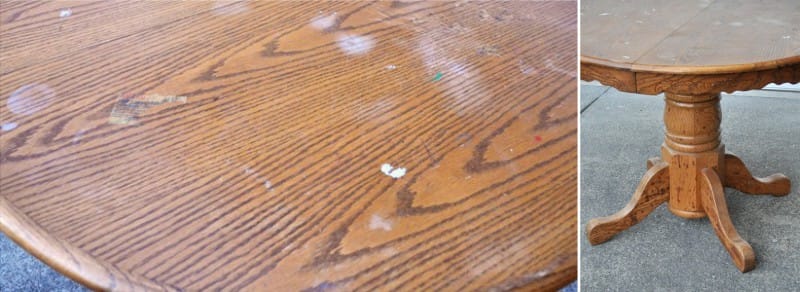 Inspect all details
Inspect all details
Remove old finishing coat
 Close up the cracks
Close up the cracks
 Prime surfaces
Prime surfaces
 Grind the table
Grind the table
 Stain
Stain
 Varnish
Varnish
























